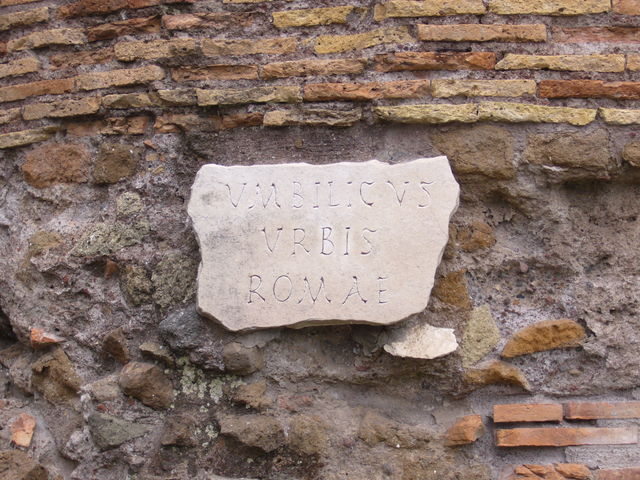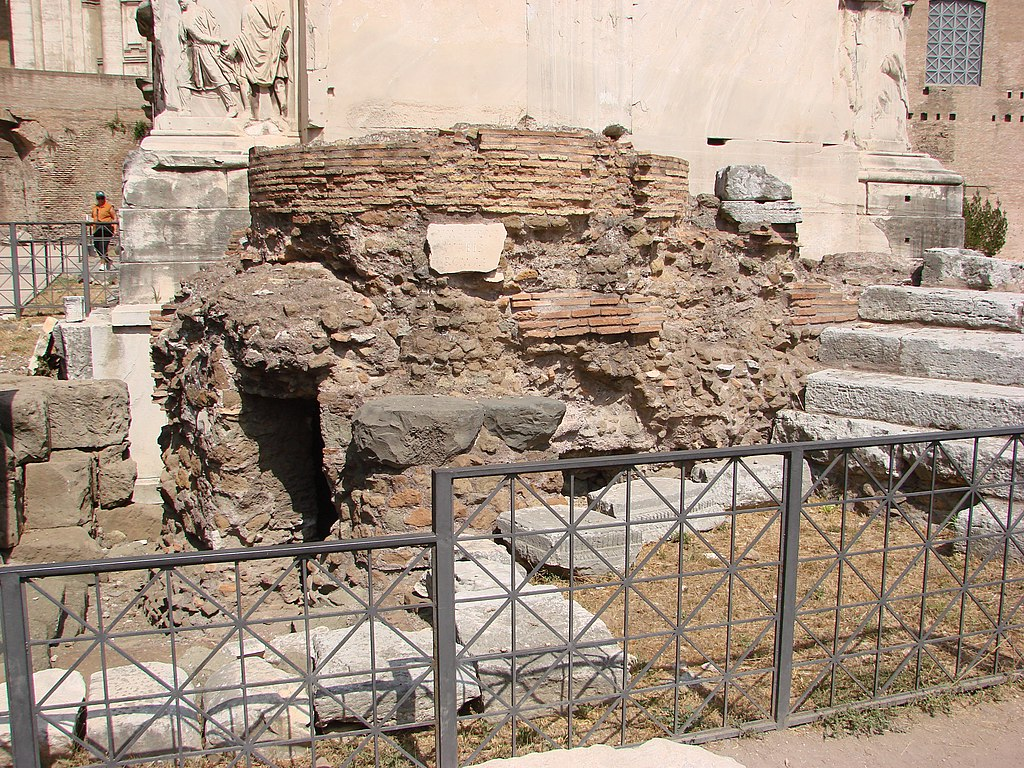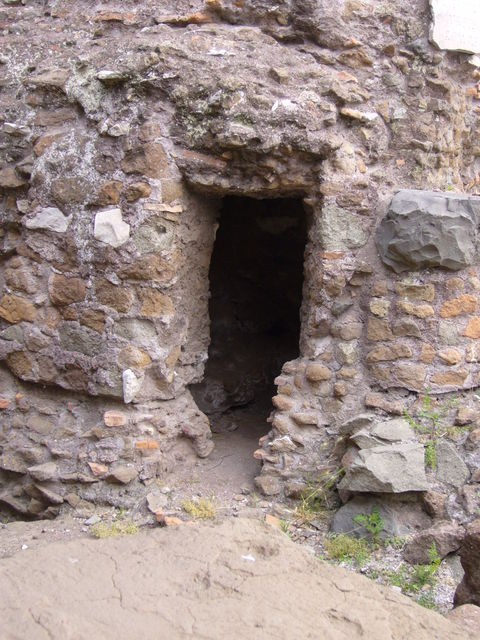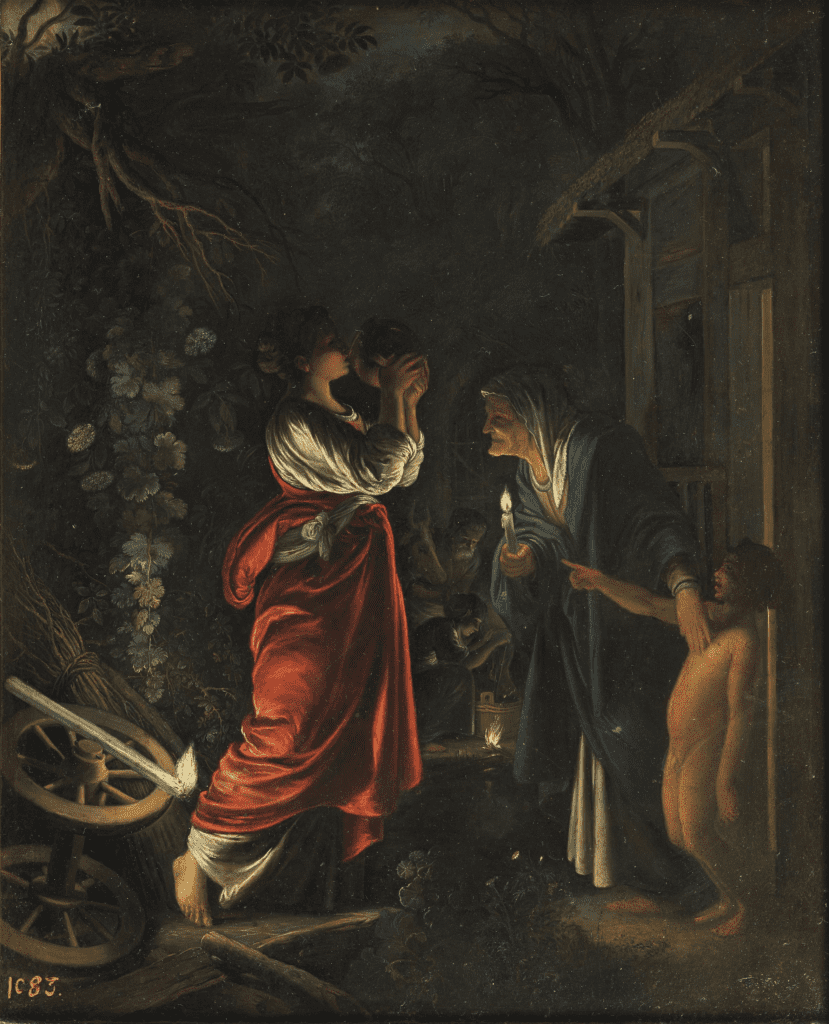
The Umbilicus Urbis Romae (“Navel of the City of Rome”) was the symbolic centre of the city from which, and to which, all distances in Ancient Rome were measured. It was situated in the Roman Forum where its remnants can still be seen. These remains are located beside the Arch of Septimius Severus and the Vulcanal, behind the Rostra. Originally covered in marble, the Umbilicus is now a forlorn-looking brick core some 2 metres high and 4.45 metres in diameter.
History
Roman legend related that Romulus, when he founded the city, had a circular pit dug in the Forum. The first fruits of the year were thrown into this pit as a sacrifice and all new citizens of Rome had to throw in a handful of dirt from their place of origin.
- “The Parallel Lives by Plutarch”. Loeb Classical Library, Harvard University Press.
The Mundus (Latin, “world”), known only from literary sources, was an underground structure considered a gate to the underworld. It may be that the Umbilicus Urbis Romae was the external (above ground) part of the subterranean Mundus. The Mundus was ritually opened only three times each year. These days were considered dies nefasti—days on which official transactions were forbidden on religious grounds—because evil spirits of the underworld were thought to escape then.
The original masonry Umbilicus was probably constructed in the 2nd century BC. The existing ruins, however, are from the time of the Emperor Septimius Severus. The construction of his triumphal arch in 203 AD encroached upon the ancient Umbilicus, which was recreated to allow more space. Fragments of the older monument were used in the new one.


The Umbilicus is believed to be a separate structure from the Milliarium Aureum, which was built nearby by Augustus (c. 20 BC) and served much the same purpose for distance reference. According to Philip Schaff, the phrase “all roads lead to Rome” is a reference to the Milliarium Aureum—the specific point to which all roads were said to lead. A marble structure speculated to be the base of the milestone is present in the Roman Forum.
- Schaff, P. (1867/1886). Ante-nicene fathers: The Apostolic fathers, Justin Martyr, Irenaeus [Roberts, A. & Donaldson, J, Eds]. [Electronic reprint] Grand Rapids, MI, USA: CCEL. 1886, v.1 p. 1
The mundus of Ceres

The mundus cerialis (or Caereris mundus, literally “the world” of Ceres) was a hemispherical pit or underground vault in Rome, now lost.[a] It was usually sealed by a stone lid known as the lapis manalis.[b] On August 24, October 5 and November 8, it was opened with the official announcement “mundus patet” (“the mundus is open”), and offerings were made there to agricultural or underworld deities, including Ceres as goddess of the fruitful earth and guardian of its underworld portals. Its opening offered the spirits of the dead temporary leave from the underworld, to roam lawfully among the living, in what Warde Fowler describes as ‘holidays, so to speak, for the ghosts’. The days when the mundus was open were among the very few occasions that Romans made official contact with the collective spirits of the dead, the Di Manes (the others being Parentalia and Lemuralia). This possibly secondary or late function of the mundus is first attested in the Late Republican Era, by Varro. The jurist Cato understood the shape of the mundus as a reflection or inversion of the dome of the upper heavens. Di Luzio observes that the Roman mundus shared functional and conceptual similarities with certain types of underground “pit altar” or megaron, used in Demeter’s Thesmophoria.
- [a] Various candidates for its location include the site of Rome’s Comitium and the Palatine Hill, within the city’s ritual boundary (pomerium)
- [b] Apparently not the same Lapis manalis used by the pontifices to alleviate droughts.
- References
- W. Warde Fowler, “Mundus Patet” in Journal of Roman Studies, 2, 1912, pp. 25–26: Warde Fowler notes the possibility that pigs were offered: also (pp. 35–36) seed-corn, probably far, from the harvest.
- Cited in Macrobius, 1.16.18.
- Festus p. 261 L2, citing’s Cato’s commentaries on civil law.
- DiLuzio, M. J., A Place at the Altar. Priestesses in Republican Rome. Princeton: Princeton University Press, 2016, pp. 113-114
A lapis manalis was either of two sacred stones used in the Roman religion. One covered a gate to Hades, abode of the dead; Sextus Pompeius Festus called it ostium Orci, “the gate of Orcus“. The other was used to make rain; this one may have no direct relationship with the Manes, but is instead derived from the verb manare, “to flow”.
The two stones had the same name. However, the grammarian Festus held the cover to the gate of the underworld and the rainmaking stone to be two distinct stones.
- Sextus Pompeius Festus, De verborum significatione, sub. tit. manalis (Latin and French text)

Gate to the underworld
See also: Mundus cerialis
Plutarch linked the Roman mundus to the religious center of the city of Rome, the umbilicus urbis Romae.
One such stone covered the mundus Cereris, a pit thought to contain an entrance to the underworld. Most cities of Latium and Etruria contained a similar pit or ditch; Plutarch describes the custom of a mundus as being of Etruscan origin, and states that it was used as a place where first-fruits were deposited.
- Plutarch, Life of Romulus ch. 11.
The Latin word mundus meant “world“. Festus, quoting Cato this time, explains that:
Mundo nomen impositum est ab eo mundo qui supra nos est.
(The mundus gets its name from that world which is above us.)
W. Warde Fowler, “Mundus Patet“, Journal of Roman Studies, Vol. 2 (1912), pp 25‑33.
The Roman mundus was located in the Comitium. This stone was ceremonially opened three times a year, during which spirits of the blessed dead (the Manes) were able to commune with the living. The three days upon which the mundus was opened were August 24, October 5, and November 8. Fruits of the harvest were offered to the dead at this time.
- W. Warde Fowler, “Mundus Patet“, Journal of Roman Studies, Vol. 2 (1912), pp 25‑33.
- Plutarch, supra.
- Lesley Adkins and Roy A. Adkins, Dictionary of Roman Religion (Facts on File, 1996) ISBN 0-8160-3005-7
Macrobius, quoting Varro, says of these days that:
Mundus cum patet, deorum tristium atque inferum quasi ianua patet.
(When the mundus is open, it is as if a door stands open for the sorrowful gods of the underworld.)
Accordingly, he reports that military and public matters were not transacted upon them, even though they were not dies nefasti.
- Macrobius, Saturnalia I 16.18
Charm to make it rain
The other was used as part of a ceremony called the aquaelicium (Latin: “calling the waters”) which sought to produce rain in times of drought. During the ceremony, the pontifices had the stone brought from its usual resting place, the Temple of Mars in Clivo near the Porta Capena, into the Senate. Offerings were made to Jupiter petitioning for rain, and water was ceremonially poured over the stone.
- Sir James Frazer, The Golden Bough ch. 5, “Magical Control of the Weather” (Abridged edition, MacMillan, 1922)
- Cyril Bailey, The Religion of Ancient Rome, ch. 2 (Archibald, Constable & Co., London, 1907)
Roman tradition held that the mundus had been dug and sealed by Romulus as part of Rome’s foundation; Plutarch compares it to pits dug by Etruscan colonists, containing soil brought from their parent city, used to dedicate the first fruits of the harvest. Warde Fowler speculates the mundus as Rome’s first storehouse (penus) for seed-grain, later becoming the symbolic penus of the Roman state. In the oldest known Roman calendar, the days of the mundus are marked as C(omitiales) (days when the Comitia met). Later authors mark them as dies religiosus (when no official meetings could be held). Some modern scholars seek to explain this as the later introduction and accommodation of Greek elements, grafted onto the original mundus rites. The rites of August 24 were held between the agricultural festivals of Consualia and Opiconsivia; those of October 5 followed the Ieiunium Cereris, and those of November 8 took place during the Plebeian Games. As a whole, the various days of the mundus suggest rites to Ceres as the guardian deity of seed-corn in the establishment of cities, and as a door-warden of the afterlife, which was co-ruled during the winter months by her daughter Proserpina, queen-companion to Dis.
- Plutarch, Romulus, 11.
- See Spaeth, pp. 63–5: W. Warde Fowler, “Mundus Patet” in Journal of Roman Studies, 2, (1912), pp. 25–33: available online at Bill Thayer’s website: M. Humm, “Le mundus et le Comitium : représentations symboliques de l’espace de la cité,” Histoire urbaine, 2, 10, 2004. French language, full preview.
- M. Humm, “Le mundus et le Comitium : représentations symboliques de l’espace de la cité,” Histoire urbaine, 2, 10, 2004. French language, full preview.
- In Festus, the mundus is an entrance to the underworld realm of Orcus, broadly equivalent to Dis Pater and Greek Pluto. For more on Ceres as a liminal deity, her earthly precedence over the underworld and the mundus, see Spaeth, 1996, pp. 5, 18, 31, 63-5. For further connection between the mundus, the penates, and agricultural and underworld deities, see W. Warde Fowler, “Mundus Patet” in Journal of Roman Studies, 2, (1912), pp. 25–33: available online at Bill Thayer’s website
See also
Wikimedia Commons has media related to Umbilicus Urbis Romae.
- Mundus Cereris
- Milion of Constantinople
- Kilometre Zero
- Datum (geodesy)
- Lemuria, another Roman festival for the dead.
- Lemures, hostile ghosts in Roman mythology.
References
- “The Parallel Lives by Plutarch”. Loeb Classical Library, Harvard University Press.
- Sextus Pompeius Festus, De verborum significatione, sub. tit. manalis (Latin and French text)
- Plutarch, Life of Romulus ch. 11.
- W. Warde Fowler, “Mundus Patet“, Journal of Roman Studies, Vol. 2 (1912), pp 25‑33.
- Plutarch, supra.
- Lesley Adkins and Roy A. Adkins, Dictionary of Roman Religion (Facts on File, 1996) ISBN 0-8160-3005-7
- Macrobius, Saturnalia I 16.18
- Sir James Frazer, The Golden Bough ch. 5, “Magical Control of the Weather” (Abridged edition, MacMillan, 1922)
- Cyril Bailey, The Religion of Ancient Rome, ch. 2 (Archibald, Constable & Co., London, 1907)
- Gilbert J. Gorski; James E. Packer (11 June 2015). The Roman Forum: A Reconstruction and Architectural Guide. Cambridge University Press. p. 155. ISBN 978-0-521-19244-6.

Leave a Reply